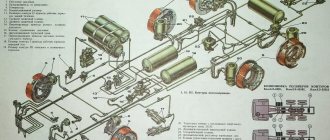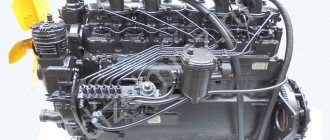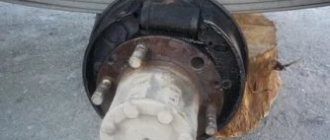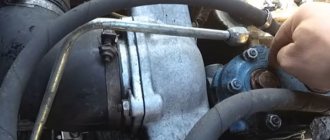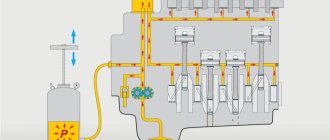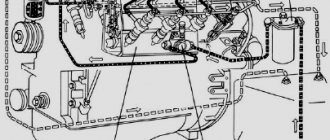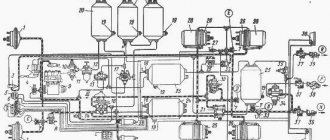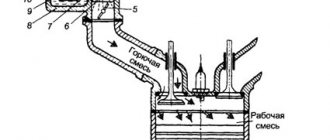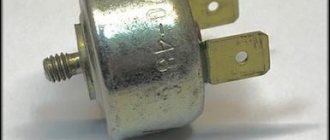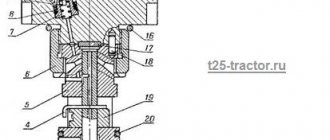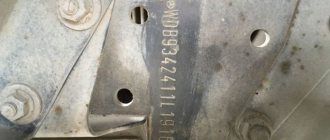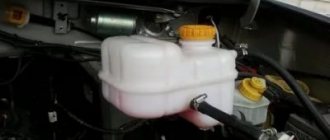“ZMZ-511” and “ZMZ-513”: briefly about the main thing
The first production engines of the Zavolzhsky Motor Plant of the 500 series appeared in the late 80s. The 3M3-511 engines for the GAZ-ZZ07 family trucks were developed on the basis of the 3M3-5Z, and the 3M3-51Z engines for the GA3-66 all-wheel drive trucks and PAZ buses were developed on the basis "3M3-66". The 511th and 513th engines have a fundamentally identical design and very similar technical characteristics.
“3M3-511” is a gasoline carburetor eight-cylinder V-shaped engine with cylinders installed at an angle of 90 degrees and an overhead valve arrangement. The working volume of the power unit is 4.254 liters. Its power is 125 horsepower, or 92 kW (at 3.4 thousand rpm). The compression ratio is 7.6. According to modern classification, this engine has an environmental class of “Euro-0”.
The 3M3-51Z engine has the same characteristics, but it has a reinforced design for operation in more difficult conditions. The differences between the 3M3-51Z and 3M3-511 engines are a different configuration of the oil pan, as well as the presence of shielding of the ignition system. The weight of the 3M3-511 motor is 262 kg, the 513th motor is 275 kilograms. Both of these power units are equipped with a clutch housing for the same unified GAZ gearbox.
The “3M3-511” (“-51Z”) engine runs on low-octane gasoline A-76 (currently branded A-80). These engines are suitable for adaptation to operation on gas, when installing a set of gas-cylinder equipment.
A Japanese passenger car engine 1UZ-FE was installed on GAZ Sadko
Installing third-party engines on our domestic trucks has become our everyday reality. Now this won’t surprise anyone. People are trying to install foreign diesel engines from Europeans or Japanese. Such modifications can be seen especially often on GAZ, ZIL and Urals vehicles.
There are entire companies that engage in so-called swapping - replacing one engine with another. The technology has been proven and on the Internet you can find detailed instructions for such alterations, which indicate all the dimensions and necessary parts.
They especially like to change the engine to a GAZ-66 because you can’t get enough gasoline for its standard one, and it drives so-so. But with a good Japanese diesel engine and a cargo automatic, this truck literally comes to life.
This topic did not pass over the GAZ-3308 Sadko
Sadko is a replacement for the GAZ-66-40, which was produced until 1999. The release of Sadko himself began in 1997. Both gasoline and diesel engines were installed in Sadko. In 2013, Sadko appeared with a YaMZ-53442 turbodiesel.
But the YaMZ turbodiesel is, of course, good. It only appeared in 2013, but the old petrol ZMZ and diesel MMZ Sadko owners are slowly replacing them with foreign engines.
It cannot be done without original and controversial solutions on the topic of replacing a standard engine. There are people who install Japanese passenger engines in such trucks
One of the common options is the Japanese 1UZ-FE
Stunning and famous engine from Toyota. 1UZ-FE is a 32 valve V-shaped 8 cylinder engine with a displacement of 4 liters and a power of 245-269 horsepower. Together with this engine there is a 4-speed automatic transmission Aisin A-340.
This is exactly the kit the guys installed in their Sadko
As is usually the case, there is very little information. But, in principle, we can assume how and what was done. The standard engine and gearbox were removed, and the Japanese units fit in there without any special modifications.
Even in the GAZ-66 this engine fits with minor modifications to the mounting points, but in Sadko it’s even easier - the hood design makes swapping even easier. Unfortunately, it is not known how the problem with the transfer case was solved because the automatic is longer than the GAZ manual.
The automatic transmission selector found itself between the seats. The guys made an indication of the selected speed on the dashboard. By the way, even though the truck is a GAZ-3308, the cab on it is from a GAZ-4301. This is how the designer turned out.
Modification "ZMZ-511.10"
In the 511th (and 51Zth too) engines, in the “3M3-511.10” modification, the following technical changes were implemented:
- cylinder heads with highly turbulent combustion chambers and helical intake ports are installed;
- an exhaust gas recirculation system was used to reduce harmful emissions into the air;
- the phases and location of the camshaft cams were changed;
- the clutch driven disc has been strengthened;
- The upper compression piston rings began to be made from more durable and high-quality cast iron of a different brand.
What can you do with this truck?
Before you begin tuning work, you should initially develop a project. It must contain all technical information. Modification of the car in question allows:
- Significantly improve interior comfort.
- Improve the driving performance of the truck. The installed chassis is not highly reliable and can make a lot of noise.
- Reduce fuel consumption and increase vehicle reliability. The truck is not known for particularly high reliability, especially after serving for several decades.
On the Internet you can find various projects, the implementation of which will make it possible to turn a car into a comfortable van with increased cross-country ability.
“3M3-511”: creativity of folk craftsmen
Thanks to its inexpensive price, simple design and good potential for boosting, enthusiastic Kulibin motorists often took it as a basis for modification and installation on Volga cars, old cars and off-road foreign cars, boats and other vehicles.
By completely regrinding the engine, using lightweight pistons and crankshaft, as well as installing a turbine on it, enthusiast motorists raise the speed of the 3M3-511 and increase its power to 200 horsepower. Practice has demonstrated the success of home-grown attempts to install injectors on the 3M3-511, transforming this typical carburetor engine into an injection one. This solution allows you to optimize fuel consumption and improve engine performance at low speeds.
Tuning
The fact is that the overall structure no longer has the original appearance it had in Soviet times. In this regard, craftsmen carry out all kinds of tuning, which concerns not only the appearance, but also the engine itself.
Engine tuning
The first step is to completely replace the old engine with a more advanced diesel engine (you can install, for example, a Volga engine).
The latter has many advantages:
- Consumes very little fuel;
- Quite a long service life, about 400 thousand mileage;
- It is very easy to maintain, change filters, oil and all kinds of belts. Assembling the Gas 53 engine is also not difficult;
- Very high efficiency.
If you decide to change the power unit, you will have to do the following operations:
- Re-weld the fastenings on the ramp;
- Replacing the fuel tank;
- Exhaust system replacement;
- Wiring;
- Design adapters and remake the driveshaft;
Tuning the cabin of a GAZ 53 car
Next, you can go to the vehicle cabin. Initially, the Gas 53 cabin does not stand out for its sophistication and comfort. Everything is made of simple plastic and thick metal. Because of this, drivers did not receive proper comfort and pleasure from driving.
Anyone can do the following:
- Install central locking;
- Install an alarm;
- Attach the lampshade from a foreign car.
Also noteworthy is the tuning of the transmission and wheels:
To do this, you can take the rear axle from Gas 3307 and install it on your car. The result is a fairly strong suspension with a self-locking rear axle.
It is worth noting that the assembly of the Gas 53 engine is carried out in any garage. This does not require a lot of space or special experience.
Many craftsmen manage to make a real pickup truck out of a simple Gas 53. A 5-liter power unit is installed in it. The weight of this engine is more than 600 kilograms.
vote
Article rating
Design features and equipment of the ZMZ-511 engine
Structurally, the power unit of this brand is designed quite simply, which has a positive effect on its reliability and durability. The basis of the 3M3-511 engine is an aluminum alloy block on which two cylinder heads are installed with a camber angle of 90 degrees. At the base of this V, formed by two cylinder heads, is a single camshaft. The force from its cams to the valves, which are installed in the upper part of the heads, is transmitted through the rods.
Between the heads there is an intake gas pipeline (manifold), on which a carburetor, an oil filter and several auxiliary components are mounted (in particular, the crankcase ventilation system, the exhaust gas recirculation system). Exhaust manifolds are installed on the outside of the heads.
On top of the power unit there is a distributor, which has a common drive from the camshaft with the oil pump. An oil pump is mounted on the rear of the 3M3-511 engine (two-section - on engines produced before 2005, single-section - in later years of production). On the front of the engine there is a water pump, which is integrated with the fan, as well as a generator. The pump and generator are driven by a V-belt drive from the crankshaft. The camshaft is driven by a gear transmission from the crankshaft.
Ignition
In this system, the main part is the distributor. The mechanism is driven by a camshaft and feeds into several high-voltage cables leading to the spark plugs. The element itself is located in the rear compartment of the intake gas pipeline near the carburetor.
The modernized ZMZ-511 power units, the characteristics of which are indicated above, use an improved oil sump design and shielding of spark plugs. As consumer reviews confirm, in general, the motors in question have proven their reliability and continue to be produced without significant changes compared to the first modifications.
Cylinder block
The block of the 3M3-511 engine is cast from AL-4 aluminum alloy, has undergone special processing and is coated with resin, which ensures its tightness. This block has three stiffening ribs in which the crankshaft bed is arranged (the main bearings (liners) are located here). Also, the liners are installed in the front and rear walls of the block. All 5 support points of the crankshaft are covered with covers on 2 bolts. Additionally, in the rear At the end there is an oil seal holder, which is closed with a separate lid through gaskets.
The engine cylinder block has a “water jacket” that surrounds the cylinders. The cylinder liners themselves are of the “wet” type. They are made of special wear-resistant alloy cast iron, and their lower part (where the collar is located) is inserted into the block. The height of the sleeves is 153 mm. Bore diameter – 100 mm. Sealing is ensured by using a copper gasket. This design solution allows you to easily change the sleeves and ensure effective heat removal from them.
The 3M3-511 engines have liners with lower fixation. They are pressed at the top by the head, and at the bottom they are sealed with copper rings. To strengthen the rigidity of the block, its lower part is located 75 mm below the axis of the crankshaft.
At the rear, the clutch housing is connected to the cylinder block. Moreover, the mating surfaces of these parts are processed individually, and therefore installation of a crankcase from another block is impossible without special modification. The clutch housing and heads are mounted on the block using studs. The oil pan is also mounted using studs of a smaller diameter. They are screwed into the bosses provided on the bottom of the block (on the flange).
The cylinder valve seats are plug-in, cast iron. Valve bushings are metal-ceramic. The valve springs and rocker arms are located in the upper part of the heads; the cylinder heads are covered with covers on top. There are 2 main types of blocks “3M3-511” - produced before 2005 - for installing a two-section oil pump; and after, in the last years of production - for the installation of a single-section oil pump. In terms of design features and characteristics, these cylinder blocks are identical. The difference is only in the configuration of the location for installing the oil pump.
The weight of the cylinder block is 44 kg. Cylinder diameter – 92 mm. Intercylinder distance (distance between the axes of adjacent cylinders of the block) – 123 mm. The diameter of the boring of the crankshaft supports (for the main bearings) is 67 mm.
Refinement of appearance
Tuning GAZ-66, GAZ-3308, GAZ-3307, GAZ-3309 involves improving the appearance of the car.
For example, you can paint the body part of a vehicle. Many drivers apply stripes along the contours of the rigid type ribs and on the tailgates. You can install an LED strip along the contour of the cabin, attaching it with plastic ties or bolts.
You can also sheathe the vehicle with sheets that will imitate armor. Plastic or steel sheets are suitable for these purposes.
It is recommended to replace the headlights with more functional optics.
This will help improve safety and visibility when driving off-road at night. Also, additional lighting elements are installed in the upper part of the cabin. You can install fog lights. During installation, they must be connected so that they are activated separately from other elements of the lighting system.
They are attached around the cabin in the form of a frame. Small arcs can be installed around the mirrors that are located on the sides.
See » Operating manual and technical characteristics of the GAZ-33081 truck
Improving the appearance of the dump truck includes installing a winch and horns.
Crankshaft and piston group
The crankshaft on the “3M3-511” is cast, with counterweights. It is made from high-strength cast iron “HF-50”, alloyed with magnesium, on motors of the 90s - with hardened necks, on later ones - without hardening them. The diameter of the main journals is 70 mm, the connecting rod journals are 60 mm. Oil seals are mounted in the front and rear parts of the crankshaft, while the front is self-clamping rubber, and the rear is based on asbestos cord. In the rear part, a flywheel is attached to the shaft with four bolts, in the front part there is a camshaft drive gear (on a key), as well as a flange for the generator drive pulley and water pump.
Connecting rods made of steel are installed on the shaft through liners (with special holes for oil leakage). The connecting rod caps are installed with bolts, which are additionally secured with sealant.
Pistons are cast, made of aluminum alloy. They are designed in a simple flat bottom configuration. The standard piston diameter is 92 mm (there are also 5 repair sizes for bored liners). The compression height of the piston is 51 mm. Weight – 565 g. The piston has 3 grooves to accommodate 2 compression rings and one oil scraper ring. The piston is installed on the connecting rod using a steel pin with a diameter of 25 mm. The piston pin has an outer diameter of 25 mm and an inner diameter of 16 mm. The outer surface of new pistons is coated with tin, which optimizes break-in.
The connecting rods on the “3M3-511” (“-513”) engines are forged to reduce weight. Length – 156 mm. The diameter of the upper head hole is 25 mm. Weight – 860 gr.
Piston
| Parameter | Meaning |
| Diameter, mm | 92,00-91,988 |
| Compression height, mm | 51,0 |
| Weight, g | 565 |
The piston pin has an outer diameter of 25 mm, an inner diameter of 16 mm.
ZMZ-511 motors began to be produced in 1959. The units were widely used on GAZ-53 and -66 vehicles and are still in use today. In the late eighties, new variations of engines of this brand were developed under series No. 500. In principle, these power units have several modifications that are equipped with the same design and parameters, differing in minor aspects.
Fuel system "ZMZ-511"
The fuel system is based on a 2-chamber K-135 carburetor (previously, K-126 carburetors were also used on 3M3-511 (“-513”) engines). The carburetor is installed at the top of the intake manifold. Each of the carburetor chambers supplies the fuel-air mixture to one of the two rows of cylinders. A fine gasoline filter is mounted close to the carburetor. Vacuum is removed from the carburetor for the operation of the distributor and the crankshaft speed limiter. Under the carburetor, in the intake gas pipeline, a vacuum outlet is also provided for the functioning of the crankcase ventilation system.
What work remains to be done?
When choosing the above motors, at the time of their installation you will have to carry out the following work:
1. Digest the fastenings on the frame. In order to be able to securely fasten the internal combustion engine structure under the hood, the engine compartment must be modified.
2.Install a different fuel tank.
3.Change the exhaust system. You will have to dismantle the original exhaust system, as well as install a new one.
4.Make some changes to the wiring.
5.Modify the cardan shaft and make the most suitable adapter.
When considering how else this car can be modified, we also note the possibility of installing power units from Mercedes. It should be taken into account that the offer from the German automaker is even more economical, the consumption rate is 15 liters per 100 km traveled.
Lubrication system
The lubrication system uses a single or 2-section gear oil pump mounted on a block. The pump is driven from the camshaft. Oil is collected from the pan by an oil receiver. Oil purification is carried out using a full-flow oil filter installed in the front of the intake manifold, in front of the carburetor. Initially, a centrifugal filter was used here, and in the last years of the model’s production it was replaced by a filter with a replaceable filter element.
Oil is supplied to the engine components through internal channels, and to the filter, or from the filter, through metal tubes. An oil cooler can be installed on the engine. The 3M3-511 engines provide protection against “oil starvation” if the oil pump is jammed. If the pump stops, the pin in its drive is cut off, and the entire motor also stops working.
How to check the GAZ 53 oil pump in the field?
The lubrication system, and in particular the oil pump of a GAZ 53 or any other car, plays a vital role in the normal operation of the internal combustion engine. Without lubrication, it will only work for a few minutes before it seizes or, worse, destroys its parts. Remember, the oil pressure sensor in the system will always signal to the driver that something is wrong with the lubrication system.
In order to take timely measures to repair or maintain a truck, it is advisable to have some knowledge of its technical characteristics, features, operating rules and car repair skills.
This is what the oil pump looks like on a GAZ-53
Overhead valve (OHV)
The gas distribution mechanism “3M3-511” is based on one camshaft, which is located at the base of the BC camber. The camshaft drive is gear-driven from the crankshaft; the gears are located on the front wall of the block and covered with a cover. Rods stretch from the camshaft to the heads, which provide drive for the rocker arms and valves.
The gasoline-air mixture is supplied from the carburetor to the cylinders through individual channels in the intake gas pipeline. The gas pipeline itself is attached to the head using studs through gaskets. The gas pipeline has a rudimentary design, it is not configured and leads to pulsations in the flow of the fuel-air mixture. This effect is reduced by the special shape of the combustion chambers and cylinder head intake channels. Exhaust gases are removed through an exhaust manifold common to the cylinders of each row. The collector is also mounted using studs, through a gasket.
GAZ F153
The owner of this unique car is a sea captain from St. Petersburg. He spent 7 years of his life on his project. The car was built from 2010 to 2022.
Only the cockpit is from the original LAWN on the hot rod; all other parts are either borrowed from other cars or made independently, by hand.
So the frame on the car is from a 1978 Chevrolet Malibu, although it is significantly strengthened. Another American car, the 1992 Chevrolet Caprice Classic, became the donor of the engine and gearbox.
In addition, the engine itself has been slightly modified. It features a new Edelbrock carburetor and intake manifold. Externally, the engine was painted and received chrome-plated camshaft block covers, which gave the engine compartment a unique appearance.
The suspension on the car is also not stock. Air springs from a modern truck are installed here.
In conclusion, I suggest you just enjoy the excellent work on the numerous photos of the GAZ F153 project:
It is clear that this car is not for every day. Its ground clearance allows the hot rod to move only on ideal roads, of which there are not yet many in Russia, and repairs will cost a pretty penny.
The author does not indicate the price of the project. Perhaps he did not count it, but it is clear that this is millions of rubles, and only on condition that the author of the project carried out most of the work independently.
Well, in conclusion, let's talk about tuning the GAZ-53, so to speak, for every day.
Technical specifications in numbers
- Number and arrangement of cylinders: 8, V-shaped.
- Working volume: 4.254 liters.
- Cylinder diameter: 92 mm, piston stroke: 80 mm.
- Compression ratio: 7.6.
- Number of valves per cylinder: 2 (1-inlet; 1-exhaust).
- The operating order of the cylinders is: 1-5-4-2-6-3-7-8.
- Rated engine power: 92 kW, or 125 hp. – at 3400 rpm.
- Maximum torque: 294 N.m, or 30 kgf.m, at a rotation speed of 2-2.5 thousand rpm.
- Minimum specific fuel consumption: 286 g/kWh, or 210 g/l S.h.
- Oil consumption for waste: 0.4% of gasoline consumption.
Installation of a more advanced diesel engine
The first thing you have to do is significantly improve the previously installed motor. However, in this case, we note that if the technical condition of the engine is poor, there is no point in upgrading it; it is better to install another power unit.
Quite often, instead of a standard gasoline engine, a diesel power unit is installed. They have the following advantages:
- Low fuel consumption. The diesel engine is famous for its efficiency and high torque.
- Long service life. With proper operation, a car can travel more than 500 thousand kilometers before major repairs.
- Compared to the original engine, diesel engines are easier to operate and only require timely replacement of filters and oil.
- Quite high efficiency. Of course, gasoline engines are superior to diesel engines in terms of efficiency, but a diesel power unit is still suitable for this vehicle.
- Diesel engines are most suitable for large vehicles due to their high traction.
Important! For the car in question, engines produced by the Minsk Motor Plant are most suitable. Motors D-245 and D-240 are suitable for this
These versions are highly reliable and simple in design. In addition, the designs in question do not require major modifications before installation on the vehicle in question.
pros
This engine consists of eight cylinders, which are arranged in a V-shape. The entire operating cycle of the engine consists of four strokes. This engine is liquid cooled. Also used here is one of the new products of the 21st century, an air recirculation system. The truck engine cylinder block is aluminum. By the way, this engine fully complies with Euro-3 environmental standards. This can be attributed to its advantages, because it means that it is not so harmful for you and me. For comparison, you can take the GAZ 3307, which was produced in the early nineties. For all its enormity, the mass of the engine itself is not that large, amounting to 275 kg.
Short description
The ZMZ-511 engine and its modifications are used for installation on medium-duty trucks, such as GAZ-53, GAZ-66, GAZ-3307. ZMZ-511 is a modernized ZMZ-53a, 53-11. The ZMZ-511 uses an untuned single-tier intake manifold, which leads to flow pulsations that negatively affect mixture formation. Cylinder heads with highly turbulent combustion chambers and helical inlet ports are used. These heads provide a compression ratio of 7.6:1, versus 6.7:1 for older engines. The ZMZ-513 engine is a modification of the 511 designed for more difficult operating conditions (for military equipment, for transporting goods in rural areas and in other difficult conditions). The engine has a number of design differences, such as a specially shaped sump for the drive axle, shielded design of electrical components, etc. The power and torque characteristics are the same. The ZMZ-513 engine is distinguished by its heavy weight - 275 kg.
Malfunctions
| FAULT | CAUSE |
| The appearance of valve knocking when the speed increases | The reason for this may be the use of low-quality gasoline, which leads to burnout of the valves. Prevention of such problems is the use of high-quality fuel, and repair consists of replacing damaged elements. |
| Insufficient pressure in the lubrication system | The oil deposit has failed, or due to the use of low-quality oil, the channels inside the engine through which the lubricant flows have become dirty. The repair in this case consists of replacing the oil pump and filter. If necessary, all internal oil passages are cleaned. This work is performed using special cleaning oil. |
| Reducing engine thrust | A decrease in engine thrust can occur for various reasons. The weak point of the engine is the deformation of the intake manifold, which occurs on cars with a mileage of more than 300-400 thousand kilometers. Repairing a damaged intake manifold involves replacing it. |
| The appearance of oil leaks in the lower part of the engine | Another weak point of this engine is the rear main bearing. It leaks regularly, resulting in significant oil loss. Repair is hampered by the inaccessible location of the rear main bearing; to replace it, it is necessary to remove all metal engine protection. |
| Oil leaks at the top of the engine | In this case, the problem is standard - it is the cylinder head gasket, which over time becomes dull and begins to leak oil. Repair - replacement of the gasket. At the same time, the condition of the valves is inspected and cleaned. |
| The coolant temperature is regularly increased to maximum | The cause of this problem is the failure of the thermostat and the pump, which is responsible for the movement of coolant in the cooling system. During repairs, the thermostat is initially dismantled, its functionality is checked and, if necessary, it is replaced. Another weak point is the cooling system pump, which must be replaced if broken. |
